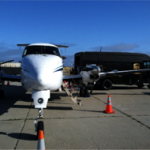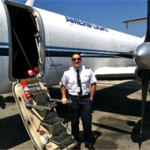Last week I completed Beech 1900 ground school covering airplane systems and operation. We spent two days doing classroom discussions and procedures training and another two days in the 1900 FTD (Flight Training Device) covering real-life scenarios (normal, abnormal and emergency). The reason flight training devices or simulators are used in airline training is because they’re cheaper to operate than the actual airplane (which are more costly to fly than a Cessna 172). Simulators also allow for the practice of emergencies that we physically cannot recreate in the aircraft for safety and/or practicality reasons.
 This week was spent in the actual airplane flying the line with a training captain, practicing maneuvers and approaches to nearby airports. This allowed me to get a more realistic feel for the airplane and also put my simulator-learned skills to the test. After flying for three days, I was signed off to take my checkride along with a company check-airmen. I took my SIC-First Officer checkride the next day with one of our Beech 1900 check-airmen and passed. Upon completing the flight, I was presented with company wings and first officer epaulets (sometimes know as shoulder bars/strips). Receiving this was such a rewarding feeling, knowing all those hours of study and years of training paid off.
This week was spent in the actual airplane flying the line with a training captain, practicing maneuvers and approaches to nearby airports. This allowed me to get a more realistic feel for the airplane and also put my simulator-learned skills to the test. After flying for three days, I was signed off to take my checkride along with a company check-airmen. I took my SIC-First Officer checkride the next day with one of our Beech 1900 check-airmen and passed. Upon completing the flight, I was presented with company wings and first officer epaulets (sometimes know as shoulder bars/strips). Receiving this was such a rewarding feeling, knowing all those hours of study and years of training paid off.
 Now that I’m certified to fly the line as a First Officer on the Beech 1900, I have the ability to fly cargo runs anywhere our Beech 1900s fly in the country, but primarily I do in the LA area. Freight-forwarding is a major part of Ameriflight’s business. How UPS and FedEx load their cargo freighters (such as Boeing 767s and Airbus A300s) is via feeder service from smaller cities. Much like how people connect at hubs when flying from one city to another, boxes have to connect as well.
Now that I’m certified to fly the line as a First Officer on the Beech 1900, I have the ability to fly cargo runs anywhere our Beech 1900s fly in the country, but primarily I do in the LA area. Freight-forwarding is a major part of Ameriflight’s business. How UPS and FedEx load their cargo freighters (such as Boeing 767s and Airbus A300s) is via feeder service from smaller cities. Much like how people connect at hubs when flying from one city to another, boxes have to connect as well.


I will be flying and working in the office routinely throughout the summer, and I will continue writing to share my experiences with you all.
Over and Out


